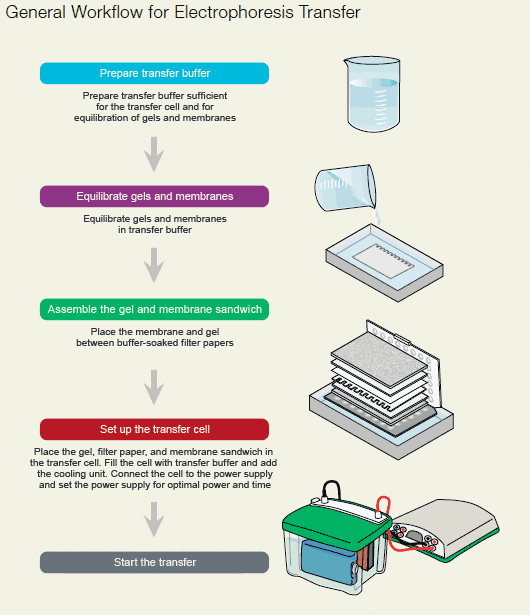Protein Immunoblotting and Electrophoresis Services
The proteins separated by electrophoresis are transferred or 'blotted' from the gel matrix to a membrane (usually nitrocellulose or PVDF), and then subsequent antibody-based detection is performed on the membrane surface. This process is known as Western Blotting or immunoblotting. Biotech company Proteintech provides protein immunoblotting analysis services. The method uses highly selective and sensitive antibody-antigen interactions to detect specific target proteins from complex protein mixtures, such as tissue homogenates or cell extracts. The resulting data can be used for qualitative and semi-quantitative analysis of target proteins.

General workflow of electrotransfer
Protein immunoblotting is a widely used protein analysis technique for detecting specific proteins in tissue homogenates or extract samples. It uses gel electrophoresis to separate native and denatured proteins based on their 3-D structures and polypeptide chain lengths. The separated proteins are transferred to a membrane (usually nitrocellulose or PVDF), and specific antibodies are used to specifically recognize target proteins on the membrane. Western blotting is widely applied in molecular biology, biochemistry, immunogenetics, and other fields of molecular biology.
In protein immunoblotting analysis, various methods are first utilized, such asSDS-PAGEand IEF, to separate proteins from samples in gel electrophoresis based on isoelectric point (pI), molecular weight, charge, or a combination of these factors. SDS-PAGE is commonly used because all proteins are dissolved in the gel and migrate in the same direction. Combined with the denaturing effect of SDS, antigenic epitopes are more easily recognized.
After gel electrophoresis analysis, proteins are transferred from the gel to membranes made of nitrocellulose or polyvinylidene difluoride (PVDF) for antibody detection. PVDF membranes have a higher binding capacity for proteins than nitrocellulose membranes, but nitrocellulose membranes bind smaller proteins better. The main method for transferring proteins is electroblotting, which uses electric current to draw proteins from the gel into PVDF or nitrocellulose membranes. Electro-transfer methods include wet transfer, semi-dry transfer, and semi-wet transfer. If isoelectric focusing is used for protein separation, pressure transfer diffusion is more effective for transferring proteins.
The transfer process can take from one hour (semi-dry transfer) to overnight (wet transfer). After the transfer, the free binding sites on the membrane are blocked by a protein mixture, so subsequent antibody detection is not interfered with. The proteins transferred to the membrane can then be subjected to antibody detection. The membrane containing proteins is first incubated with a primary antibody, followed by a secondary antibody that recognizes the primary antibody. The secondary antibody is usually conjugated with a reporter group and has high sensitivity.
The most sensitive detection method is using enhanced chemiluminescence (ECL), which involves recognizing the primary antibody with an antibody-horseradish peroxidase conjugate. Special variants of enhanced chemiluminescence can detect protein bands as low as 1 pg.
Protein immunoblotting can also be used to trackprotein phosphorylation, with antibodies that bind to all isoforms of phosphorylated proteins presenting a 'bead-like' appearance on a 2-D gel. It can also be used to identify known and unknown proteins in complexes produced by immunoprecipitation, as long as the target protein is in the gel, the corresponding spot can be cut from the gel and subjected to subsequent mass spectrometry identification using Coomassie Brilliant Blue staining.
How to order?





